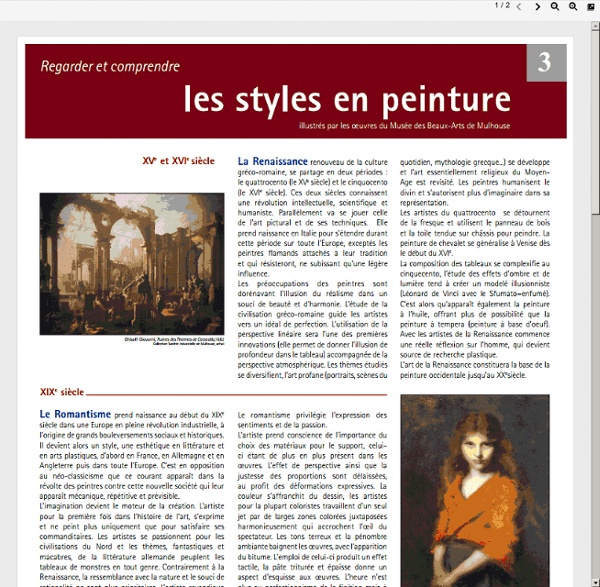



Lettres-et-Arts.net Mouvements artistiques POPARTis POPARTis est la référence Pop art sur le Web : dossiers spéciaux, actualités et oeuvres d'art Pop art y sont régulièrement ajoutées. » www.popartis.com Cubisme Le mouvement artistique du cubisme est l'une des plus importantes périodes de l'histoire de l'art, grâce aux peintres Picasso et Braque » www.cubisme.org Surrealiste L'art surréaliste est l'un des styles artistiques des plus marquants de l'art moderne. » www.surrealiste.net Dadaïsme Le Dadaïsme, importants mouvements artistiques du 20e siècle, apparu dans une période sombre, vsitez dadaisme.org pour mieux comprendre ses artistes. » www.dadaisme.org Futurisme Le futurisme est un mouvement artistique et social qui a pris naissance en Italie au début du 20ème siècle, et une célébration de la jeunesse et de l'industrialisation.» www.futurisme.net Hyperréalisme Classicisme » www.classicisme.net Renaissace » artiste.org Maniérisme Ce site Web exclusif au artistes et au mouvement artistique Maniériste. » www.le-manierisme.com Fauvisme
La Grotte Chauvet-Pont d'Arc - Ardèche, France Aller au contenu Page d'accueil Menu du site Glossaire En poursuivant votre navigation sur ce site, vous acceptez l'utilisation des cookies. En savoir plus Fermer ce volet Musée d'Archéologie nationale Accéder au contenu Visite virtuelle Découvrez la grotte originale, salle par salle Vidéo 18 décembre 1994 : récit de la découverte Au plus près de l'art pariétal Explorez les images très haute définition des œuvres de la grotte La vallée de l'Ardèche L'environnement à l'époque paléolithique Les Hommes de Chauvet-Pont d'Arc Culture et société des Aurignaciens et des Gravettiens La recherche Le programme, les enjeux, l'équipe La découverte et la conservation Préserver et transmettre un patrimoine inaccessible Chronique de la grotte Ressources vidéos sur l'histoire de la grotte et les recherches Visitez la réplique de la grotte Informations pratiques pour visiterla réplique de la grotte Un projet de haute technologie Un incroyable défi technologique, artistique et scientifique La technique est extraordinaire
Liens Utiles Dictionnaires Glossaires Mise à jour le 15 juin 2020, proposez vos liens ABC du VIN: ce site traite du vocabulaire du vin dans son ensemble, dégustation, mesure, œnologie, tonnellerie, viticulture, cépages... et propose en tout 7 dictionnaires, le vocabulaire du vin avec 4 dictionnaires : vocabulaire technique du vin, personnalités du monde du vin, mentions du vin, vocabulaire de la dégustation; le lexique des cépages et les appellations et crus classés ABCMUSIQUE: abécédaire, glossaire de la musique ABREVIATIONS-ACRONYMES-(1): très pratique pour en connaître la signification, plus d'un million d'entrées, en anglais mais plusieurs en français ABREVIATIONS-ACRONYMES-(2): Ackr, dictionnaire multilingue des acronymes, recense et traduit les sigles, abréviations et acronymes du monde; du finnois au russe, de l'anglais à l'espéranto, plus de 45000 acronymes issus de 170 langues ABREVIATIONS-ACRONYMES-(3): EspaceFrançais, liste des abréviations les plus employées CUISINE-(2): un glossaire des termes culinaires
Récapitulatif des huiles essentielles par maux Pas facile de s’y retrouver dans toutes ces huiles essentielles, certaines ont des vertus multiples, voici un petit récapitulatif de leur utilisation, classé par maux du quotidien. Sphère intestinale Les huiles essentielles utiles Huile essentielle d’anethHuile essentielle de basilicHuile essentielle de basilic à linalolHuile essentielle de cardamoneHuile essentielle de carviHuile essentielle de citronHuile essentielle de petit-grain citronHuile essentielle de curcumaHuile essentielle de combavaHuile essentielle de coriandreHuile essentielle de fenouilHuile essentielle de genièvreHuile essentielle de girofleHuile essentielle de khellaHuile essentielle de laurier nobleHuile essentielle de livècheHuile essentielle de menthe poivréeHuile essentielle de romarin cinéoleHuile essentielle de thym à linalolHuile essentielle de poivre noirL’extrait de pépins de pamplemousse Phytothérapie Drainage du foie : Le Chardon marie, une plante alliée du foie Sphère Circulatoire Stress – nervosité – anxiété Acné
Argot - Expressions familières Ces pages ne sont pas définitives mais s’enrichissent peu à peu des expressions rencontrées dans les différents billets de ce blog, avec des exemples supplémentaires pour vous aider à mieux les utiliser. Les expressions les plus récemment ajoutées sont au début. A consulter régulièrement donc ! Vous pouvez écouter tout ça: j’enregistre ces exemples au fur et à mesure. J’essaie aussi de préciser le degré de familiarité, si c’est nécessaire. Petite tentative d’organisation: – Expressions diverses et variées – Expressions « culinaires »: basées sur la nourriture et l’alimentation. – Expressions « corporelles »: on y trouve mentionnées des parties du corps. – Expressions en couleur : toutes nos expressions qui contiennent des couleurs. – Expressions « animales » : celles qui contiennent des noms d’animaux. – Insultes et « gros mots » : à utiliser avec précaution ! J'aime : J'aime chargement…
I LOVE LIRE (+ 100 000 livres en ligne) | - Iceweasel Cette sitographie mise à jour régulièrement est composée de trois parties : 1) des livres, BD, encyclopédie, ouvrages scolaires, plans, cartes, revues, etc. 2) Poésie, pièces de Théâtre et dans notre fonds documentaire, 3) des livres à écouter sur tous supports (Web, tablettes…) Des livres que tu peux télécharger, lire, écouter, échanger, utiliser pour tout ce qu'il te plaira. Tu trouveras des livres utiles, au programme des classes d'école, de collège et de lycée. Et ne manque pas de revenir de temps en temps : nous rajouterons régulièrement de nouveaux textes et de nouveaux compléments. Et pour ceux qui ont des difficultés avec la lecture : Des livres, BD, encyclopédie, ouvrages scolaires, plans, cartes, revues… La Bibliothèque Nationale de France vous propose de découvrir sur son portail Gallica ses collections patrimoniales numérisées, ainsi que celles des bibliothèques partenaires. Le site Web :
La banque d'images française Stockvault.net - Free Photos Images